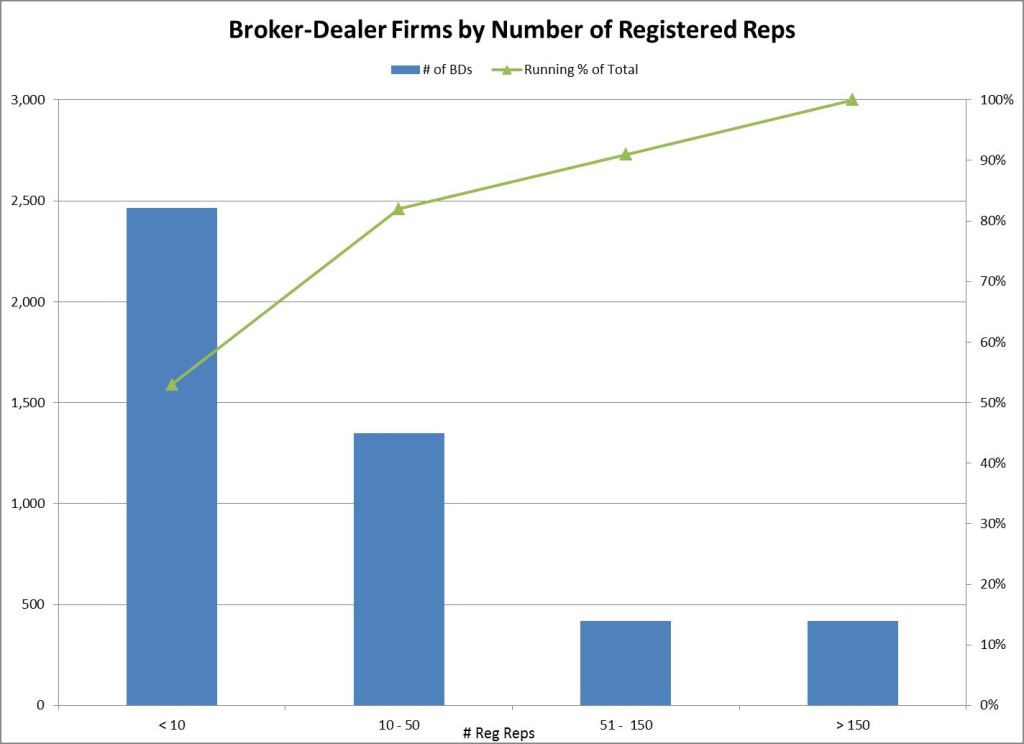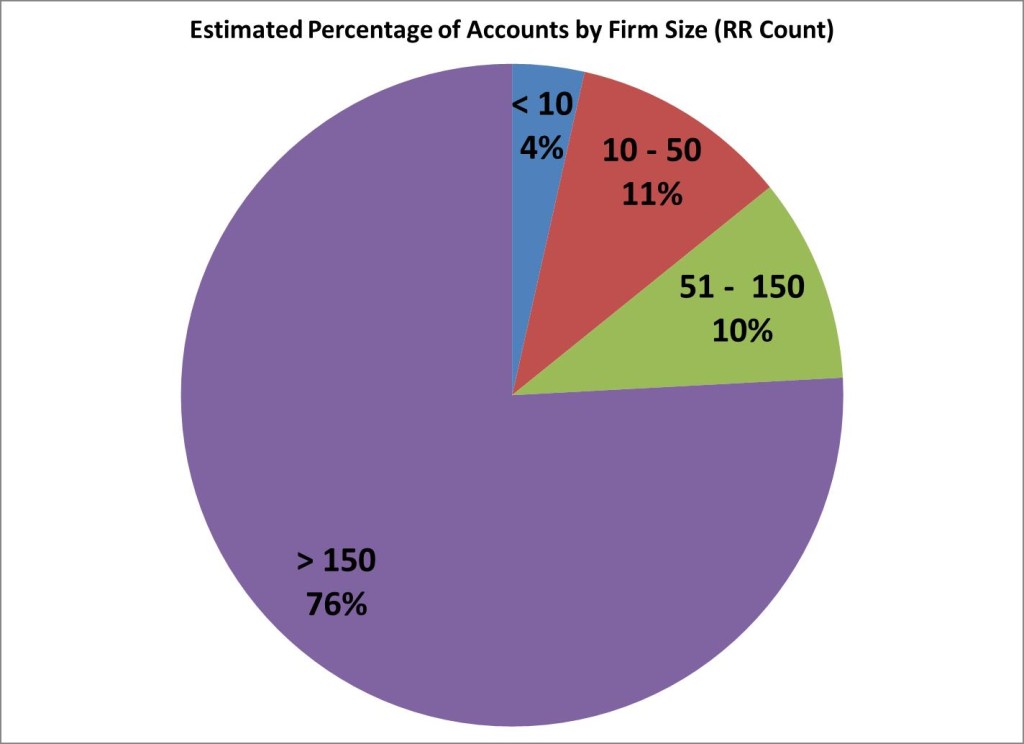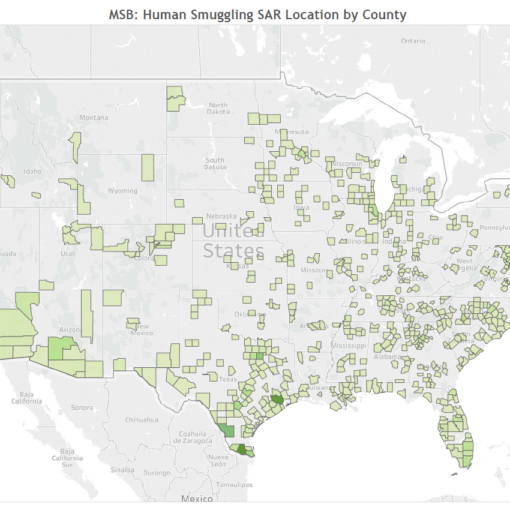It’s Suspicious to Not be Suspicious
SEC Enforcement Chief Andrew Ceresney made headlines when he said:
I can say that the number of firms that filed zero SARs or one SAR per year was disturbingly large.
Unfortunately, Chief Ceresney did not provide the number of broker-dealer firms that filed zero or 1 SAR per year. Nor did FinCEN respond to an Freedom of Information Act request for that data. Ceresney continued:
Consider another fact. There are approximately 4,700 to 4,800 broker-dealers in the United States, all of whom are required to file SARs in appropriate circumstances. When you compare that number with the number of SARs filed by broker-dealers every year, that means that on average, each firm in the U.S. files about five SARs per year. This is disconcerting and hard to understand.
DSA attempted to understand why a broker-dealer (“BD”) would file zero SARs. DSA crunched available data to determine the expected distribution of SAR filings by broker/dealer size.1 DSA’s analysis assumes that there is a strong correlation between the number of accounts held at a firm and the number of SARs filed.2
Most Broker-Dealers are Small
First let’s look at the distribution of registered representatives/principals across all FINRA registered broker-dealers. We see that 53% of all broker-dealers employ less than 10 registered representatives and only 9% of firms employ more than 150 registered reps. 91% of BDs are considered “small firms” by FINRA, meaning that these firms employ less than 150 registered reps.

Big Firms Dominate Account Numbers
Next, let’s consider the customer account distribution across the 4,648 broker-dealers registered with FINRA. The SEC stated that there were about 109 million BD accounts in 2010 while FINRA reported that there were 630,692 registered reps in 2014. Therefore, the average number of accounts per registered rep is 173. DSA estimates that firms with less than 10 registered reps hold only 4% of customer accounts although these firms comprise 53% of BDs. The 4,230 broker-dealers with less than 150 registered reps hold 24% of accounts while the remaining 418 “large firms” hold 76% of all accounts.

More Accounts, More SARs
DSA calculated that firms with less than 10 registered reps filed on average 0.32 SARs in 2014. In other words, only 1 out of 3 of these small firms filed a SAR. In 2014, there was one SAR filed for every 4,855 broker-dealer accounts. The SEC can not simply mandate that certain firms file more SARs. In order for small firms with small customer bases to file more SARs, all BDs must file more SARs due to the account distribution across firms. Otherwise, the SEC would in effect be saying that customers at small firms are by default more suspicious. For instance, if every small firm filed 1 SAR and the largest firms continued to file SARs at the rate of 1 per 4,855 accounts, then small firms would be filing SARs at a rate 3 times that of large firms.
Is the SEC suggesting that customers who choose to invest with regional BDs are three times as suspicious as those who invest at international conglomerates?
If the SEC will only be happy when every BD firm files at least one SAR, then 70,000 SAR-SFs will need to be filed in a year. This would be a three-fold increase over current SAR-SF filing rates. Chief Ceresney was also disturbed that many firms only file one SAR per year. SAR-SF filings would need to jump to 140,000 per year or 1 SAR-SF per every 778 accounts in order for every BD to file at least 2 SARs. This would result in large BDs filing an additional 89,000 SAR-SFs in order for the small firms to capture an additional 4,132 SARs.

While the SEC is considering SAR filing factors like:
whether the firm retailed microcap securities or was dually registered as an investment advisor; the number of regulatory, civil, or criminal disclosures related to the firms; and the number of times the firm was involved in transactions that the Division has investigated in the past.
The fact alone that a BD did not file any SARs or just 1 SAR should not be surprising or disturbing. It should be expected for about 35% of BDs.
____________________________________________________________________________________________________
1 Data sources: “Study on Investment Advisers and Broker-Dealers” US Securities and Exchange Commission, January 2011. FinCEN SAR Stats for 2014.
2 FinCEN does not regularly release data that would confirm or disprove the assumption that firm size is correlated to the number of SARs filed by a financial institution. However, FinCEN noted that “the largest five financial institutions (based on asset size) accounted for 21% of total SAR filings in 2006.”
DSA acknowledges the following: (1) customers are not the only entities that SARs are filed against, see our blog post here, (2) SAR-SFs are filed by financial institutions other than broker-dealers, (3) customer type, geographic location, product types, etc will effect the number of SARs filed by an institution. DSA’s estimates are purely estimates as FinCEN and the SEC provide extremely limited data publicly on SAR-SF filings and even that data can be unreliable.




